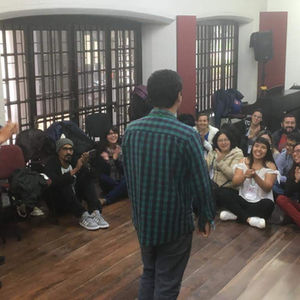RUBEN PARDO
Pianist, researcher and teacher
Scenic Fear
A somatic view of musical performance
One of the primary objects of any artistic manifestation is communication, the ability to transmit, show or significantly affect our environment and our reality. As artists, many times we dedicate ourselves to delving into disciplinary, conceptual or technical aspects of our work as musicians, but we put aside considering what we feel when sharing with the other, setting aside fundamental emotional aspects that, although they are not strictly disciplinary they substantially affect the communicative act, in our case musical.
As an instrumentalist, researcher and teacher, you have the opportunity to see how possible inhibitions can produce very negative effects on musical performance, which can range from losing aspects worked on in a work to having a complete block that paralyzes and does not even allow you to approach a stage, preventing a public musical experience. It is considered then that this dimension of the musician should be an active part of their musical training.
Workshop given at the Vi Musical Research Meeting 2018

It starts from the idea of looking for spaces that, in the first measure, allow us to recognize many of these inhibitions in musical practice, and from there, begin an exploration that leads to knowing and implementing effective strategies to achieve greater interpretive freedom. Thus, building meaningful experiences that place the rationalization of movement and body awareness, as well as study methodologies and orality, as fundamental resources for effective communication in musical interpretation.
It is evident that many of these inhibitions at the level of stage fright or glossophobia (fear of public speaking) have their main basis in the body's reaction to emotional crises such as fear of failure, fear of the opinion of the other, fear of mistake, etc., using the resources of the living arts is a very useful and effective strategy to face them. In this way, from a multidisciplinary perspective and through a continuous process of self-knowledge and reflection, to be able to generate changes that rationalize movement and emotional response. The pedagogical process then becomes an experimental laboratory in which each participant knows their needs. , is exposed in a controlled space and generates the necessary changes to recognize their inhibition, improve their communication skills when interpreting their instrument or simply speaking in front of the public.
Objectives of the project:
Generate a space that considers the ability to communicate effectively in musical performance as an aspect that should be included in musical training.
Through a laboratory of construction and experimentation, it is intended to understand and rationalize the block in the communicative act, first in a general way, and then to be able to generate actions that reduce the inhibition produced by sharing a musical experience in a collective way.
Lines of action:
Body as the foundation of interpretation
-General muscle examination and on the instrument
-Body awareness
-Breathing
-Concentration
-Use of voice as recognition and fundamental communication channel
Body expression
-Initial expression
-Rational expression
-Inhibitory activity
-Creative thinking
-Emotional gesture
Self-knowledge
-Self criticism
-Self-perception
-Autonomy
-Tried
-Group feedback
Technique
-Study methodologies
-Nonverbal language
-Oculésica
-Haptic
-Kinetic
-Isopraxis
-Proxemia
-Planification and organization
-Use of space
-Exhibition activities
Cross-cutting axes of action
-Body-voice- rationalization of movement
-Study methodology
-Instrumental practice

Workshop given at the Latin American Seminar on Music Education 2019
Gallery











